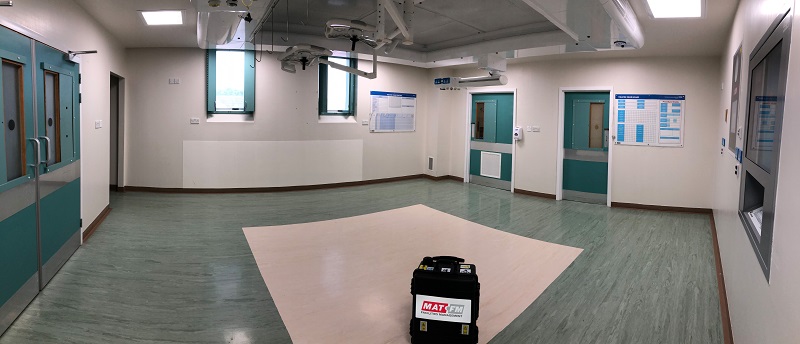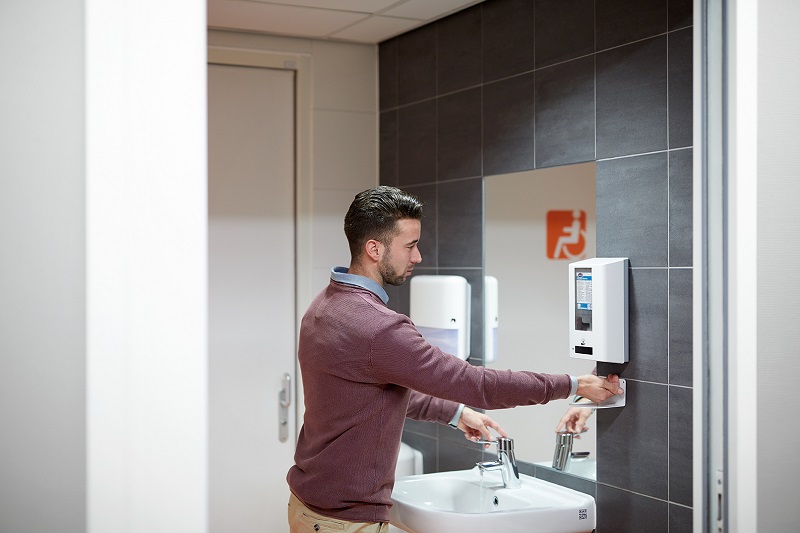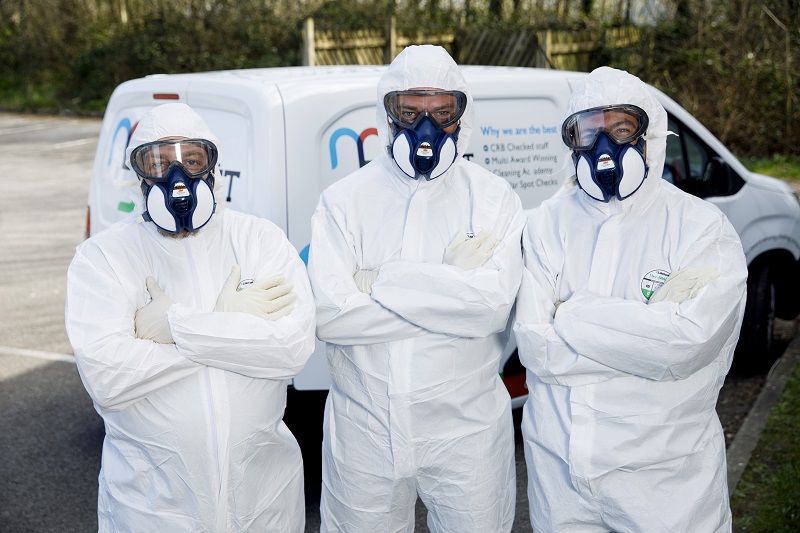Environmental decontamination is a critical tool in healthcare settings during the current pandemic.
The Department of Health and Social Care (DHSC), Public Health Wales (PHW), Public Health Agency (PHA) Northern Ireland, Health Protection Scotland (HPS) and Public Health England recently published joint COVID-19 guidance for infection prevention and control in health settings.
It states that patient isolation rooms, cohort areas, and clinical rooms must be decontaminated at least once daily, and all clinical rooms should be decontaminated after clinical sessions involving patients with suspected, or known, coronavirus.
The amount of misinformation or misuse of industry terminology is leading to greater confusion, higher risk of spread, and a higher potential for dissatisfaction
In addition, patient isolation rooms must be terminally cleaned following discharge or transfer, or when vacated by staff following an aerosol generating procedure (AGP); and decontamination schedules should be carried out more frequently in areas where there may be higher environmental contamination rates, such as toilet facilities; and where there are high-touch surfaces such as medical equipment, door handles, and call bells.
Out of touch
In this case the guidance states that these surfaces should be cleaned at least twice daily, or when known to be contaminated with secretions, excretions or bodily fluids.
But what does this mean for estates and facilities teams?
A spokesman for the Infection Prevention Society said: “Studies tell us that COVID-19 behaves like SAR-CoV and is associated with significant contamination of the environment.
“The solution to this problem is regular cleaning of the environment, especially high-touch surfaces, with detergent and chlorine-based solutions.”
But, speaking to BBH, a spokesman for hygiene and cleaning solutions company, Diversey, said formulations containing Accelerated Hydrogen Peroxide (AHP) offered numerous advantages over traditional chlorine in the current climate, though, to date, no specific products have been thoroughly tested on coronavirus itself.
“One tactic for improving environmental hygiene, the cleanliness of surfaces, in healthcare settings is to use the right disinfectants. However, not all disinfectants are created equally,” he adds.
“Cleaning professionals have traditionally chosen disinfectants with chlorine as the active ingredient, usually as bleaches, for cleaning hard surfaces in care settings.
“However, there are some drawbacks that can limit their usefulness.
“Alternative formulations with AHP as the active ingredient offer numerous advantages with few limitations.”
And the key requirement from any disinfectant in healthcare settings is efficacy.
Dr Stefan Wagener, a scientific advisor and trainer at the Global Biorisk Advisory Council (GBAC) and executive director of Biorisk International, told BBH that the virus can stay on certain surfaces for up to a week or longer and touching these surfaces, and then your mouth, nose, or eyes is considered a potential route of transmission.
Coughing and sneezing are major problem areas, with faecal matter is also assumed to be a source.
He said: “As the coronavirus has been identified as an enveloped virus, similar to influenza, we have proven cleaning methodologies and protocols which we can bring to bear as we try to combat its spread.
“However, the amount of misinformation or misuse of industry terminology is leading to greater confusion, higher risk of spread, and a higher potential for dissatisfaction.
“For COVID-19 we need to disinfect surfaces and objects that are potentially contaminated with the virus AND are frequently touched and/or used.
Whole-room decontamination through airborne fogging or spraying is likely to be the most-suitable and effective intervention as it disinfects the air and uses smaller particles sizes, enabling a disinfectant to reach the areas that viral particles may reach
“For surfaces that are soiled we need a two-stage process.
“First, surfaces must be cleaned to remove soil. Secondly, they should be disinfected with appropriate chemicals and processes.
“It’s about selecting what is most suitable and approved.”
Spreading rapidly
The Diversey spokesman adds: “The SARS-CoV-2 coronavirus, which causes the disease COVID-19, has spread rapidly.
“New information about the illness is being discovered every day. For example, we know that it is a respiratory virus, like influenza and SARS.
“It is also an enveloped virus and, therefore, easy to kill, and disinfectants with virucidal claims such as EN14476 - either fully virucidal or limited virucidal - will be effective against it.
“Keeping surfaces clean to remove pathogens of concern is a critical step in breaking any potential chain of infection.”
In many settings solutions such as Diversey’s Oxivir range of products are being widely specified.
Each product contains patented AHP and this dramatically increases the potency and cleaning performance against a wide range of pathogens, including coronavirus.
The simplest, and quickest, way to introduce this innovative infection prevention performance is with products such as Oxivir Excel, which come in a ready-to-use form.
The cleaner disinfectant can be used for regular and daily cleaning on a wide range of surfaces, working in just 30 seconds.
Also advising hospitals up and down the country is Medical Air Technology (MAT).
Its business development manager, Will Evans, told BBH: “There is currently a lack of direct evidence for any disinfectant efficacy against coronavirus. However, in the absence of direct evidence, disinfection would still be a good thing to do.
“Whole-room decontamination through airborne fogging or spraying is likely to be the most-suitable and effective intervention as it disinfects the air and uses smaller particles sizes, enabling a disinfectant to reach the areas that viral particles may reach.”
Like Diversey, he advises the use of hydrogen peroxide (H2O2).
“Touchless H202 disinfection has many benefits,” he says.

Medical Air Technology is advising hospitals up and down the country on its whole-room fogging and spraying technology, which helps address even hard-to-reach places
Quick and effective
“It is effective, always killing 99.99% of harmful pathogens; it’s quick, taking just a few minutes to treat a standard area; it can be undertaken with minimal disruption, which is important in healthcare settings; it is suitable for many different environments and surfaces; it is delivered in a single application; and it is non toxic and non allergenic. Additionally, it costs less than many traditional cleaning methods.
“The process of airborne fogging is quick to deploy and is the most-effective kill solution for airborne viruses, which seldom simply rest on surfaces, to be cleaned away.
“Due to the particle size, particles will also remain in the air and our process is dry and can be used on all surfaces and materials, including paper and electrical items. And it does not put any additional risk on the user as the process is touchless.”
He concludes: “We believe this approach is much more effective than a deep clean because any manual clean process is labour intensive and places the personnel directly at risk from contaminated surfaces. It also allows the opportunity for cross contamination to transfer virus particles through human transfer or via equipment.
“At a practical level, a single fogging process can treat an area of 1000 cubic metres an hour with a single operator and a single set of personal protective equipment (PPE). The same area would require a team of 12 to achieve a clean in the same timescale and would utilise 12 sets of PPE, which would then need to be disposed of to avoid cross contamination.”
Whatever approach hospitals use, getting expert advice is crucial.
Following an increase in requests for its bio-decontamination services, Interfurn is making its BIOAct-365 decontamination solution available as part of a planned cleaning and maintenance programme, or as a rapid emergency response by hospitals to the current pressures.
No pathogen can withstand exposure to Ultraviolet ‘C’ or develop ‘resistance’ to it. Correctly deployed, UVC will kill airborne coronavirus dead
As well as general areas, the service is suitable for operating theatres, critical care and recovery areas as well as areas housing immunocompromised patients.
It provides a cost-effective and scalable solution for most areas from 5sq m to 200sq m, delivering a highly-purified hydrogen peroxide vapour capable of eliminating 99.9999% of known pathogens and leaving no residue.
No special preparation is necessary and the vapour is non corrosive and safe to use on sensitive electronics, including ultra-clean ventilation canopies, operating lights, and medical monitoring equipment.
A spokesman said: “Additionally, using a high-level disinfectant to maintain the levels of cleanliness is recommended.
“There are a number of medical-grade disinfectants that are known to eliminate other similar coronaviruses and areas can be ‘misted’ or ‘fogged’ with these to ensure even coverage of all areas, including the inside of cupboards, drawers etc if they are left open during the process.
“The regular disinfection of ‘high-traffic’ areas such as door handles, keyboards, phones, desks, light switches etc – any area that comes into contact with people throughout the day - will reduce the spread.”
Bioquell, an Ecolab solution is another firm offering a solution, through its Hydrogen Peroxide Vapour Rapid Bio-decontamination Service (RBDS).
A study published in the April 2014 issue of The Journal of Hospital Infection evaluated the in-vitro efficacy of Bioquell Hydrogen Peroxide Vapour for the in-activation of a number of structurally-distinct viruses that could impact the healthcare, veterinary and public sectors.
And the findings showed that after exposure to Bioquell’s Hydrogen Peroxide Vapour, no viable viruses were identified.
The technology was also evaluated by the UK Government’s Biosafety Group at the Centre for Emergency Preparedness and Response at Porton Down, using the non-enveloped virus surrogate MS2 phage, with full inactivation achieved.
A Bioquell spokesman said: “Respiratory viruses can contaminate and survive for long periods on environmental surfaces. Therefore, effective disinfection is essential for stopping transmission from the environment.
”However, this is not always achieved by conventional cleaning and disinfection techniques.
”Bioquell’s Hydrogen Peroxide Vapour is a vapour-phase disinfection method that is virucidal on structurally-distinct viruses dried on surfaces.
”It achieves a level of efficacy unmatched by standard cleaning practices and other disinfection technologies. And it is uniform across the entire target area and not limited to line-of-sight or easy-to-reach spaces.
”Bioquell’s RBDS can be quickly called upon to eradicate coronavirus from a single area, several locations within a facility, or an entire building.”
Another rapid COVID-19 services has been set up by Mrs Buckét, which has been successfully rolled out over the last few weeks to GP surgeries, mail-room depots and manufacturing sites to help halt the spread of the virus.
As part of the service, a team of specialists operates over several hours, often through the night, methodically working their way through a building.
All surfaces and touchpoints throughout are sanitised and cleaned, and a professional fogging machine is used alongside specialist chemicals to ensure all fabric, surfaces and carpets are fully cleansed.”
Mrs Buckét founder, Rachael Flanagan, said: “Maintaining high standards of hygiene has never been more important than it is now, particularly for areas with high footfall that are likely to be contaminated, such as doctors’ surgeries.
“We have developed strict procedures for decontaminating buildings and have spent some time training our team to ensure they are able to deliver the highest-quality service, while ensuring they remain safe at work.
“I am hugely proud of the vital role each and every one of my team members are playing in helping to fight the spread of COVID-19.”

Diversey is advising of the importance of good hand hygiene to prevent further spread of the virus
Taking to the air
Hospitals also need to pay close attention to HVAC systems, which can provide another way for viruses to spread.
Hillary Spicer, managing director of E-CO, a provider of high-intensity UVC solutions for HVAC systems, said: “A particular problem for hospitals is that they commonly recirculate air. This, in turn, recirculates aerosolised viruses such as COVID-19. There is no technology installed that intercepts and kills these viruses.
Even in settings such as hospitals, where poor hand hygiene can have serious consequences, studies suggest that processes can be improved, compliance rates increased, and infection rates reduced
“However, no pathogen can withstand exposure to Ultraviolet ‘C’ or develop ‘resistance’ to it. Correctly deployed, UVC will kill airborne coronavirus dead.”
She advises the use of active and passive UVC through the deployment of hand-held devices which disinfect surfaces; in-ceiling products which can be used in operating theatres and isolation rooms; in-room purification systems such as its SterilZone; and portable UVC which can be wheeled between rooms.
Also helping to reduce viral burden on surfaces is Biomaster, whose proven antimicrobial technology has been found to be effective at reducing the viability of viruses on porous surfaces, including treated fabrics and papers.
The company’s regulatory affairs officer, Lesley Taylor, said: “COVID-19 relies on a protective lipid coating.
“Unlike many gastrointestinal viruses, such as Norovirus, which have a tough protein shell called a capsid enveloped virus; viruses with this lipid coating are relatively vulnerable and easier to destroy.
“Alcohol-based products, for example, disintegrate the protective lipids. And quaternary ammonium disinfectants, commonly used in healthcare, attack protein and lipid structures, thwarting the pathogen’s typical mode of infection.
“Bleach and other potent oxidisers will also break down the essential components of a virus.
“These methods are highly effective at removing dangerous pathogens from surfaces, but they only remain effective for up to two hours maximum; and any new microbes landing on the surface after that will continue to thrive.”
In independent lab tests, analysis identified that Biomaster fabric spray was effective at reducing the viability of Norovirus applied to textiles, such as protective facemasks and cubicle curtains.
Taylor said: “Biomaster has yet to be tested against COVID-19 on this type of application and currently there is no method available by which it could be tested.
“However, although we do not yet have any data, the microbiology suggests that if Biomaster is effective against Norovirus on porous surfaces, then the active agent is also likely to have an effect on the lipid coating and the essential components required for COVID-19 to function and invade a host.
“Unlike alcohol-based gels, disinfectants and oxidisers, Biomaster technology is effective 24/7 for the lifetime of the treated article.
“It could, therefore, complement current hygiene guidance offering additional product protection.
“The most-important thing at this time is to follow the official advice and keep safe.”
It’s in your hands
Moving forward, hand hygiene will also provide a key infection prevention tool for UK healthcare operators.
The majority of infections – around 80%, according to studies – are passed by hand-to-hand contact or by touching a contaminated surface.
The Diversey spokesman explains: “One would imagine that hand hygiene would be the easiest of everyday activities to get right. But studies have shown that relatively-large numbers of people forget – or refuse – to do this.
“Even in settings such as hospitals, where poor hand hygiene can have serious consequences, studies suggest that processes can be improved, compliance rates increased, and infection rates reduced.”

Mrs Buckét has set up a rapid COVID-19 service sanitising and cleaning GP surgeries and other high-risk environments
The Government COVID-19 guidance document states that all staff, patients and visitors should decontaminate their hands with alcohol-based hand rub when entering and leaving areas where care for –suspected and confirmed COVID-19 patients is being delivered.
Hand hygiene must be performed immediately before every episode of direct patient care and after any activity or contact that potentially results in hands becoming contaminated, including the removal of personal protective equipment (PPE), equipment decontamination, and waste handling.
It provides further guidance on how to properly wash hands and for how long.
Many infectious diseases are spread by personal contact or touching a contaminated surface. This means keeping hands clean will remove any pathogens and break one of the key links in the chain of infection
It also states that staff should wear disposable gloves at all times when providing direct patient care, changing them before and after every task.
The spokesman for Diversey said hospitals should be using alcohol rubs with at least 70% alcohol content and handwashing for at least 20 seconds with soap and water.
“The link between hand hygiene and the spread of infections is established and understood,” he added.
“Many infectious diseases are spread by personal contact or touching a contaminated surface. This means keeping hands clean will remove any pathogens and break one of the key links in the chain of infection.
“Choosing suitable hand cleaners and disinfectants – and efficient dispensers – can help to further reduce infection rates.”
Diversey ranges include Soft Care and SURE and it also has a range of colour-coded soaps, sanitisers and creams which are helping hospitals to keep on top of hygiene requirements.
